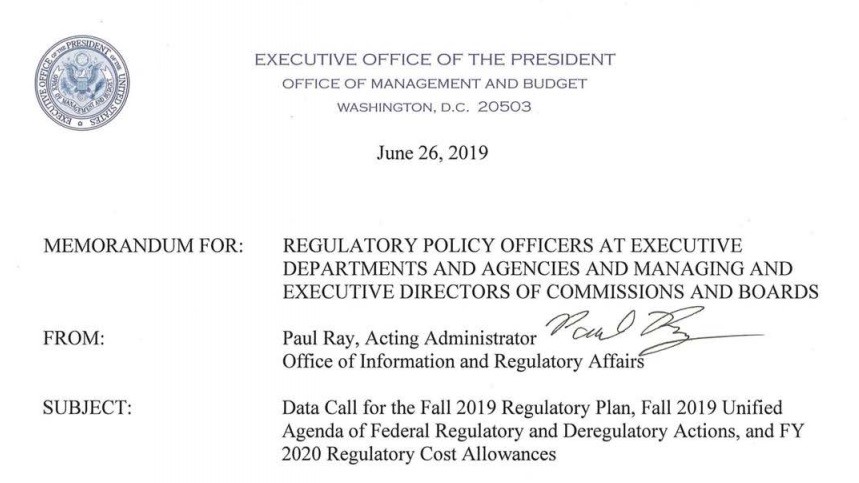Week in Regulation
July 15, 2019
SEC Finalizes Most Expensive Regulation of Trump Era
In a week that would have otherwise been marked by the official publication of the Environmental Protection Agency’s (EPA) repeal of the Clean Power Plan (CPP), it was the Securities and Exchange Commission (SEC) that stole the show. SEC has now finalized the costliest rule since Donald Trump became president and pushed this past week’s regulatory cost total to a level unseen in years. Across all proposed and final rules, agencies published $29 billion in total net costs and added 13 million hours of paperwork.
REGULATORY TOPLINES
- New Proposed Rules: 54
- New Final Rules: 49
- 2019 Total Pages: 33,624
- 2019 Final Rule Costs: $38.4 Billion
- 2019 Proposed Rule Costs: $1.7 Billion
The driver of the week was the SEC rule regarding “Regulation Best Interest: The Broker-Dealer Standard of Conduct.” The rule is SEC’s attempt to update certain investor protections in light of the demise of the Department of Labor’s (DOL) “Fiduciary Rule.” The American Action Forum’s Thomas Wade explained the proposed version here. There is some controversy over whether or not this rule is the proper replacement for DOL’s previous regulation, but there’s no denying that it establishes quite the administrative regime in-and-of itself. In examining simply the paperwork burdens involved, SEC estimates that the price tag for this rule is “approximately $27.5 billion.” Of course, SEC is an independent agency outside of the direct control of the White House and not subject to the regulatory budget under Executive Order (EO) 13,771. Nevertheless, it is a remarkable total given the overall regulatory trends of the past couple of years.
TRACKING THE REGULATORY BUDGET
In terms of rules that do factor into the EO 13,771 tally for fiscal year (FY) 2019, the highlight of the week was EPA’s “Affordable Clean Energy” (ACE) rule – its plan to “repeal and replace” the CPP. As we further detail here, what many expected to be one of the premier deregulatory actions of this administration (at least for EO 13,771 purposes) turned out to be among the most regulatory of its final rules. Under the new baseline that essentially disregards the CPP and presents the ACE rule as a functionally de novo action, affected entities can expect annual compliance costs of $110 million, or $970 million in present value under a 7 percent discount rate. This pushes EPA even farther back from its FY 2019 goal of $817.8 million in net savings with only two and a half months left to bridge the gap.
So far in FY 2019 (which began on October 1, 2018), there have been 53 deregulatory actions (per the rubric created by EO 13,771 and the administration’s subsequent guidance document) against 29 rules that increase costs and fall under the EO’s reach. Combined, these actions yield quantified net costs of roughly $11.4 billion. This total, however, includes the caveat regarding the baseline in the Department of Agriculture’s “National Bioengineered Food Disclosure Standard.” If one considers that rule to be deregulatory, the administration-wide net total is approximately $4.7 billion in net costs. The administration’s cumulative savings goal for FY 2019 is approximately $18 billion.
THIS WEEK’S REGULATORY PICTURE
This week, outlining the FY 2020 regulatory budget.

The acting administrator of the Office of Information and Regulatory Affairs (OIRA), Paul Ray, recently distributed a memorandum to federal agencies setting expectations for the next regulatory budget. The FY 2020 regulatory budget will once again aim to hold executive agencies at or below zero net costs (the costs of significant regulatory actions less the savings from deregulatory actions).
While the agency-specific details will be worked out in a deliberative process between each agency and OIRA, the memo states that “OIRA expects that each agency will propose a net negative regulatory cost allowance for FY 2020.”
The memo also spells out when agencies must submit their accounting for the FY 2019 regulatory budget, which established a target of $17.9 billion in net savings. How agencies do with respect to their FY 2019 targets could affect their cost caps for FY 2020, particularly if they need to finalize more savings to offset increases in regulatory costs.
At last check, many agencies had a lot of work to do. At the time it appeared the administration would achieve its government-wide target with room to spare, but the change in the accounting of the ACE rule has put that objective in jeopardy.
TOTAL BURDENS
Since January 1, the federal government has published $40.1 billion in net costs (with $38.4 billion in finalized costs) and 38.8 million hours of net paperwork burden increases (with 35.8 million coming from final rules). Click here for the latest Reg Rodeo findings.












